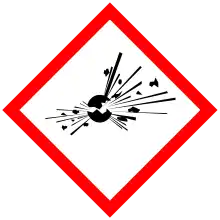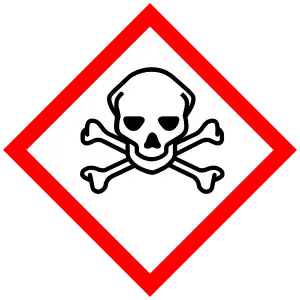Copper(II) azide
Copper(II) azide is a medium density explosive with the molecular formula Cu(N3)2.
_azide.JPG.webp) | |
| Names | |
|---|---|
| IUPAC name
Copper(II) azide | |
| Identifiers | |
3D model (JSmol) |
|
| ChemSpider | |
PubChem CID |
|
| UNII | |
CompTox Dashboard (EPA) |
|
| |
| |
| Properties | |
| Cu(N3)2 | |
| Molar mass | 147.586 g/mol |
| Appearance | brown orthorhombic crystals |
| Density | 2.6 g/cm3 |
| Melting point | Explodes when heated |
| Hazards | |
| GHS labelling: | |
  | |
| Danger | |
| NFPA 704 (fire diamond) | |
| NIOSH (US health exposure limits): | |
PEL (Permissible) |
TWA 1 mg/m3 (as Cu)[2] |
REL (Recommended) |
TWA 1 mg/m3 (as Cu)[2] |
IDLH (Immediate danger) |
TWA 100 mg/m3 (as Cu)[2] |
| Related compounds | |
Other cations |
Lead(II) azide Silver azide Sodium azide |
Except where otherwise noted, data are given for materials in their standard state (at 25 °C [77 °F], 100 kPa).
Infobox references | |
Uses
Copper azide is very explosive and is too sensitive for any practical use unless handled in solution.
Preparation
Copper azide can be prepared by a metathesis reaction between water-soluble sources of Cu2+ and azide ions. (Spectator ions omitted in reaction below).
- Cu2+ + 2 N−3 → Cu(N3)2
It can be destroyed by concentrated nitric acid to form non-explosive products, these being nitrogen, nitrogen oxides and copper(II) nitrate.
References
- Lide, David R. (1998), Handbook of Chemistry and Physics (87 ed.), Boca Raton, Florida: CRC Press, pp. 4–55, ISBN 0-8493-0594-2
- NIOSH Pocket Guide to Chemical Hazards. "#0150". National Institute for Occupational Safety and Health (NIOSH).
This article is issued from Wikipedia. The text is licensed under Creative Commons - Attribution - Sharealike. Additional terms may apply for the media files.
